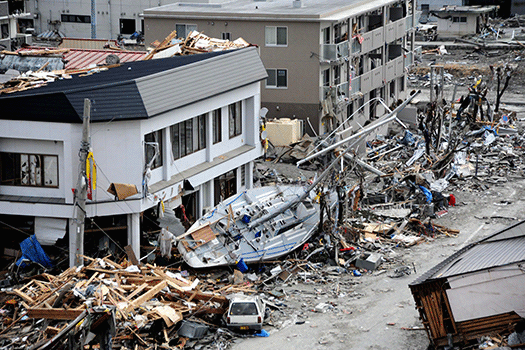Japanese Tsunami

Animals:
Several zoos and aquariums were reported by Kazutoshi Takami, a veterinarian at the Osaka Municipal Tennoji Zoological Gardens, to have shortages of gas, heater fuel, food and drinkable water for humans as well as for animals. He also said that the Fukushima Aquarium had made plans to move their sea mammals and birds to Kamogawa Sea World.
M. Sanjayan of The Nature Conservancy in Arlington, Virginia, told Science Insider that the largest influence on wildlife would be that shorebirds would nest on small islands throughout the Pacific, rather than on the Japanese mainland. Most wildlife-related news of the tsunami came from small Pacific islands such as those in the Midway Atoll National Wildlife Refuge.
DAMAGE:
Enviroment:
Some environmental problems were the onslaught of seawater overloaded with residues and pollutants. Aquifers, the primary source of drinking water, were contaminated with saltwater, raw sewage, oil, and other pollutants.
Costly Damage:
The national police agency of Japan reported on March the 8th that there was 15 854 deaths and 3 203 missing in Japan The tsunami caused 1 death in Jakarta, Indonesia and one in Klamath River, California. The tsunami caused over $200 billion in damage and caused damage 16 000 km always at Isla Chiloe. Chile had $6 million in losses to the fishing industry in Tongoy. Hawaii was left with $30 million damage and there was $70 million damage in California.
Nuclear Plant:
The tsunami resulted in a nuclear accident with explosions and leaks in 3 reactors at the Fukushima nuclear Power station. The cores of three reactors melted at the Fukushima Dai-ichi plant following the tsunami, and radioactive water has been stored in more than 1,000 tanks. 100 Tons of contaminated water overflowed through a rainwater drainage pipe and workers had to attach garbage bags to contain the leak.
Help of World Vision:
Six Months after the tsunami has happened local economies are still struggling in Japans Coastal Towns. World Vision has placed a helping hand in for Children and fishing industries.
“No country would have been able to protect itself against an earthquake and tsunami the scale of which we experienced,” said Mariko Kinai, World Vision’s emergency response director in Japan.
“Six months later, the survivors are still living with uncertainty and hardship. This isn’t something you can recover from quickly.”
Fishing Industry
The fishing industry is working at 20% of its normal capacity in the coastal town of Kesennuma. Still thousands in the local workforce are without jobs. To renew interest in the fishing industry world vision will be launching a campaign in local high schools.
“Economic recovery is key,” Kinai said. “By assisting local fishermen with new equipment and supplies, World Vision is able to help jumpstart the industry and promote long-term re-growth. This has a direct benefit to children whose parents are currently out of work.”
Toll On Children:
Miyagi and Iwate prefectures, two of the hardest-hit areas have been the main focus for world vision. To give children a chance to recover from the emotional and psychological toll of the disaster they have set up child friendly spaces.
“There have been literally hundreds of aftershocks that make children continuously anxious. After each one, they relive the nightmare of March 11,” Kinai said. As recently as August 18, a 6.8-magnitude earthquake sent tremors through the region.
Immidiate:
Long term:
 Dogs Stay Together |  Porpoise RescuedPet shop owner rescues Porpoise from rice paddy field |  Ban Reunited With OwnerBan was stranded on top of his house roof for three weeks with no food or water. |
|---|---|---|
 First Wave |  Damage |  Resucers |
 Nuclear Plant Explosion |  Scanning Of Radioactivity |